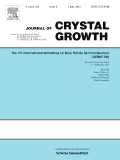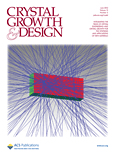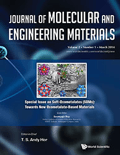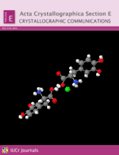
JOURNAL OF CRYSTAL GROWTH
Scope & Guideline
Advancing Knowledge in Crystallization Science
Introduction
Aims and Scopes
- Crystal Growth Techniques:
The journal publishes research on various crystal growth techniques, including Czochralski, Bridgman, and vapor phase methods. Studies often focus on optimizing conditions for improved yield and quality of crystals. - Material Characterization:
Papers frequently address the characterization of crystals, including structural, optical, and electrical properties, using techniques such as X-ray diffraction, photoluminescence, and electron microscopy. - Defect Engineering:
Research on the formation, characterization, and mitigation of defects in crystals is a significant focus, including studies on dislocations, vacancies, and impurities that affect material performance. - Novel Materials and Applications:
The journal covers the growth and application of novel materials, such as semiconductors, ferroelectrics, and scintillators, emphasizing their potential in electronic, photonic, and energy applications. - Theoretical and Computational Modeling:
Many articles employ theoretical and computational approaches to model crystal growth processes, helping to predict outcomes and optimize growth parameters.
Trending and Emerging
- Advanced Characterization Techniques:
There is a growing trend in the use of advanced characterization techniques, such as in-situ monitoring methods and synchrotron-based studies, to better understand crystal growth mechanisms and defect formation. - Sustainable and Green Synthesis:
Research focusing on eco-friendly and sustainable methods for crystal growth is on the rise, driven by the global push for greener technologies and materials. - 2D Materials and Nanostructures:
The study of 2D materials, such as graphene and transition metal dichalcogenides, is emerging as a significant theme, with researchers exploring their unique properties and applications in electronics and photonics. - Machine Learning in Crystal Growth:
The application of machine learning and AI in optimizing crystal growth processes is becoming increasingly prominent, with researchers leveraging data-driven approaches to enhance growth efficiency and material quality. - Multifunctional and Hybrid Materials:
There is a marked increase in research on multifunctional and hybrid materials that combine different properties for specialized applications, particularly in the fields of optoelectronics and energy harvesting.
Declining or Waning
- Traditional Crystal Growth Methods:
There appears to be a waning interest in traditional methods like bulk crystal growth techniques, as researchers increasingly explore innovative and hybrid approaches, including additive manufacturing and nano-crystallization. - Inorganic Materials:
Research on purely inorganic materials, particularly those with limited application scopes, is declining as the field shifts towards more complex hybrid materials and organic-inorganic composites. - Low-Temperature Growth Techniques:
There is a noticeable decrease in studies focused on low-temperature growth techniques, as the community appears to favor high-temperature methods that yield higher quality and more complex structures. - Non-Material-Specific Studies:
Papers that do not focus on specific materials or applications are less frequent, as there is a growing emphasis on tailored solutions and applications in areas such as electronics and photonics.
Similar Journals

Crystallography Reviews
Illuminating the World of Crystal StructuresCrystallography Reviews is a premier academic journal published by Taylor & Francis Ltd, dedicated to advancing the field of crystallography and its applications across various scientific domains. With an ISSN of 0889-311X and an E-ISSN of 1476-3508, this journal has established itself as a vital resource for researchers and practitioners since its inception. It encompasses a broad scope, including insights into biochemistry, general chemistry, condensed matter physics, materials science, and structural biology, reflecting a multidisciplinary approach that is essential in today’s research environment. As indicated by its 2023 quartile rankings, it holds a distinguished position in the Q1 category for Condensed Matter Physics and Q2 in several other significant fields. Notably, it ranks #31 in the Scopus category for Structural Biology, underscoring its influence and relevance. Although it does not offer Open Access options, the journal maintains a strong commitment to quality and rigor in its publication process. For scholars and students striving for a competitive edge in crystallographic research, Crystallography Reviews serves as an indispensable tool for disseminating pivotal findings and fostering academic dialogue.

APPLIED PHYSICS A-MATERIALS SCIENCE & PROCESSING
Advancing Knowledge at the Intersection of Physics and EngineeringApplied Physics A: Materials Science & Processing, published by Springer Heidelberg, is an esteemed academic journal that has been at the forefront of innovative research since its establishment in 1995. With a strong focus on the intersection of physics, materials science, and engineering, this journal explores cutting-edge developments and applications that influence contemporary materials research. Categorized in the Q2 quartile across both Chemistry and Materials Science, it boasts respectable rankings in Scopus, affirming its influence and reach within the academic community. Although primarily a subscription-based journal, it is dedicated to disseminating high-quality research findings that advance our understanding in these fields. Researchers, professionals, and students alike can benefit from the journal's commitment to publishing comprehensive studies, methodological advancements, and insightful reviews that push the boundaries of knowledge in materials science.

Acta Crystallographica Section B-Structural Science Crystal Engineering and Materials
Exploring the intricate world of crystal engineering and material synthesis.Acta Crystallographica Section B: Structural Science, Crystal Engineering and Materials, published by the International Union of Crystallography, stands as a pivotal resource for researchers and professionals in the fields of materials science, crystal engineering, and structural biology. With an e-ISSN of 2052-5206, this journal is recognized for its contributions to advancing knowledge on the structural aspects of materials, drawing significant interest from the Q2 category in several disciplines, including Atomic and Molecular Physics and Materials Chemistry. As the field evolves through innovative research approaches and methodologies, the journal actively covers developments within the scope of materials synthesis, characterization, and application in various sectors including medicine and electronics. Though not an open-access journal, it is entangled in the scientific discourse, ensuring that key studies are accessible to academic institutions and professionals globally. With a commitment to excellence, its impact across multiple quartile rankings signifies its influence and importance for scholars eager to contribute to cutting-edge research.

Physics and Chemistry of Solid State
Exploring the Depths of Solid-State Phenomena and ChemistryPhysics and Chemistry of Solid State is a distinguished open access journal published by Vasyl Stefanyk Precarpathian National University in Ukraine, dedicated to advancing research in the fields of condensed matter physics, materials science, and physical and theoretical chemistry. Since its inception in 2000, the journal has provided a platform for the dissemination of innovative ideas and original research findings, contributing significantly to the global scientific community. With a variety of access options, it facilitates the sharing of knowledge and collaboration among researchers worldwide. The journal has garnered recognition with respectable rankings in Scopus, positioning itself among the significant publications in its domain, particularly noted for its contributions to materials science and condensed matter physics. As it moves through its converged years from 2018 to 2024, Physics and Chemistry of Solid State aims to foster interdisciplinary dialogue and prepare the next generation of scientists to tackle complex challenges in solid-state research.

CRYSTAL GROWTH & DESIGN
Exploring the Frontiers of Crystal ScienceCRYSTAL GROWTH & DESIGN, published by the American Chemical Society, is a premier journal dedicated to the interdisciplinary study of materials science, condensed matter physics, and miscellaneous chemistry. With an ISSN of 1528-7483 and E-ISSN of 1528-7505, this journal provides a vital platform for the dissemination of innovative research findings from 2001 through 2024, reflecting the dynamic advancements in crystal growth and design methodologies. It is recognized for its impact in the field, earning a distinguished placement in the Q2 quartile across categories of Chemistry, Condensed Matter Physics, and Materials Science for 2023. Researchers engaging with CRYSTAL GROWTH & DESIGN will find a wealth of peer-reviewed articles encompassing cutting-edge experimental techniques, theoretical frameworks, and application-oriented studies. Although not an open-access journal, it remains a critical resource for academics, professionals, and students aiming to enhance their understanding of crystal growth processes and material functionality, with Scopus rankings reflecting its reputable authority within the scientific community.

Journal of Molecular and Engineering Materials
Pioneering Insights in Molecular Engineering and Material ScienceThe Journal of Molecular and Engineering Materials, published by World Scientific Publishing Co Pte Ltd, is a leading peer-reviewed journal that focuses on the intricate relationship between molecular science and engineering practices. With the ISSN 2251-2373 and E-ISSN 2251-2381, this journal aims to foster the exchange of cutting-edge research and developments within the fields of materials science, molecular engineering, and related applications. Although the journal currently does not operate under an Open Access model, it remains a vital resource for researchers, professionals, and students seeking in-depth knowledge and innovative methodologies in material design and engineering. The journal's esteemed reputation is reflected in its commitment to publishing high-quality research that addresses contemporary challenges and opportunities in material science, thereby contributing to advancements in technology and industry.

Acta Crystallographica Section E-Crystallographic Communications
Unlocking the mysteries of crystals, one communication at a time.Acta Crystallographica Section E-Crystallographic Communications is a premier academic journal dedicated to the field of crystallography, published by the International Union of Crystallography. With an Open Access model established since 2008, this journal fosters the rapid dissemination of significant research findings in crystallographic studies, offering researchers and professionals the ability to freely share and access critical data. The journal is recognized for its contribution to various interdisciplinary categories, achieving notable standings in the 2023 rankings, categorized in the Q3 quartile in Chemistry (miscellaneous) and Materials Science, and the Q4 quartile in Condensed Matter Physics. By bridging the gap between theoretical and practical aspects, Acta Crystallographica Section E serves as a vital resource for those looking to deepen their understanding of crystallographic phenomena and its applications in science and engineering. The journal maintains its commitment to quality and innovation in research, ensuring a vibrant platform for scholarly communication within the scientific community.

Journal of the Korean Crystal Growth and Crystal Technology
Illuminating the Path of Crystal Science DevelopmentJournal of the Korean Crystal Growth and Crystal Technology, published by the Korean Association for Crystal Growth, Inc, serves as a significant platform for the dissemination of research related to crystal growth and technology, emphasizing advancements in the field within the context of Korean and global scientific communities. With its ISSN 1225-1429 and E-ISSN 2234-5078, this journal invites contributions that explore the theoretical and practical aspects of crystal growth, including material science, physics, and engineering applications. Although specific metrics such as HIndex or Scopus ranks are currently unpublished, the journal is poised to impact the field significantly, appealing to researchers, professionals, and students seeking to expand their knowledge and expertise. By fostering collaboration and sharing innovative findings, the Journal of the Korean Crystal Growth and Crystal Technology is a valuable resource for those aiming to contribute to this evolving discipline.

Liquid Crystals Reviews
Unraveling the Mysteries of Liquid CrystalsLiquid Crystals Reviews, published by Taylor & Francis Ltd, is an esteemed journal dedicated to the nuanced field of liquid crystal technology and its applications. With an ISSN of 2168-0396 and an E-ISSN of 2168-0418, this journal has established itself as a vital resource for researchers, professionals, and students alike, providing a platform for rigorous peer-reviewed articles and innovative research findings. Impressively, it holds a Q1 ranking in Chemistry, Condensed Matter Physics, and Materials Science as of 2023, underscoring its significance in these disciplines. The journal spans a convergence period from 2013 to 2024, inviting high-quality contributions that lead to foundational advancements in understanding the properties and uses of liquid crystals. While the journal is not open access, its impact on the scientific community is profound, serving as a cornerstone for knowledge dissemination and advancement in liquid crystal research. Located in the United States with its publishing office in England, Liquid Crystals Reviews operates at the crossroads of innovation and academic excellence.

Crystals is a premier open-access journal, published by MDPI since 2011, that focuses on the multidisciplinary fields of chemical engineering, condensed matter physics, inorganic chemistry, and materials science. With its E-ISSN 2073-4352, the journal is headquartered in Switzerland, and actively contributes to the global scientific community by facilitating the dissemination of high-quality research. Ranking in the Q2 quartile across multiple categories, including Chemical Engineering (miscellaneous) and Materials Science (miscellaneous) for 2023, Crystals provides a platform for innovative studies that span from fundamental research to practical applications. The journal's commitment to open access ensures that groundbreaking findings are readily available to researchers, professionals, and students alike, fostering an environment of collaboration and knowledge sharing that is essential in advancing the scientific understanding of crystalline materials.